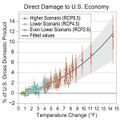File:RCP-projections-damage to US economy.jpg: Difference between revisions
Siterunner (talk | contribs) No edit summary |
Siterunner (talk | contribs) No edit summary |
||
| Line 19: | Line 19: | ||
''I'd like to push back a little.'' | ''I'd like to push back a little.'' | ||
''In Chapter 2, (link: https://nca2018.globalchange.gov/chapter/2/) | ''In Chapter 2, (link: https://nca2018.globalchange.gov/chapter/2/), a 90% likelihood range of ~4.5 to ~9.8 F is indicated for RCP8.5, with a most likely value of about 7 F.'' | ||
(review the history of RCP science and statistics) | (review the history of RCP science and statistics) | ||
Revision as of 19:08, 29 November 2018
Representative Concentration Pathway
Projections of possible 'economic impact' on the US economy are represented in graphic format, as with the attached slide.
Robert Rohde's point out in a Tweet thread, here https://mobile.twitter.com/RARohde/status/1067375439415582721, that the projections were reported by the US media without specifying the range of possible outcomes in sufficient detail.
As Robert puts his case in his series of Tweets:
In the reporting on the National Climate Assessment, some articles (such as this by @CNN) have focused on the far end of the risk distribution and say that "the economy could lose ... more than 10% of its GDP" by 2100.
I'd like to push back a little.
In Chapter 2, (link: https://nca2018.globalchange.gov/chapter/2/), a 90% likelihood range of ~4.5 to ~9.8 F is indicated for RCP8.5, with a most likely value of about 7 F.
(review the history of RCP science and statistics)
He then refers to Ch. 29 of the report and the following:
...the high estimate comes from RCP8.5 (red dots), an emissions scenario which assumes extremely aggressive growth of CO2 emissions.
While possible, I certainly wouldn't regard RCP8.5 as a likely future.
More importantly, a close examination of the GDP figure will notice that there are many red dots associated with RCP8.5. The distribution of red dots reflects an uncertainty in the climate's response to this much CO2, and covers a very large range from 4 F to 14 F at 2100.
This presented range is huge. In fact, it is substantially larger than the response range presented elsewhere in the same report. In Chapter 2, (link: https://nca2018.globalchange.gov/chapter/2/) nca2018.globalchange.gov/chapter/2/, a 90% likelihood range of ~4.5 to ~9.8 F is indicated for RCP8.5, with a most likely value of about 7 F.
One can, and should, make the case that current projections of impacts are being dismissed by a large swath of political voices, generally from conservative business interests and tradition religious points of view.
The science however on the reality of climate change/global warming is convincing in its facts and details.
What is up for debate now is how fast will the impacts of human and earth system changes impact life, economics and ecology, as we know it.
File history
Click on a date/time to view the file as it appeared at that time.
| Date/Time | Thumbnail | Dimensions | User | Comment | |
|---|---|---|---|---|---|
| current | 18:52, 29 November 2018 |  | 600 × 600 (62 KB) | Siterunner (talk | contribs) |
You cannot overwrite this file.